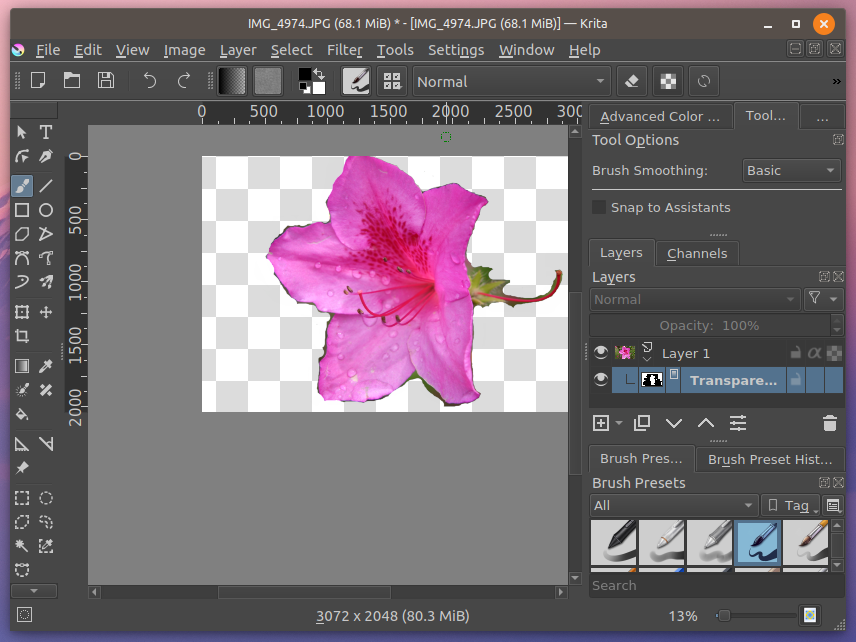

Video of how to use the anchor point for resizing.
#Deselect krita free
While free transform has some perspective options, the perspective transform allows for maximum control. You can drag the corner points, or even the designated vanishing point. You can also change the size, shear and position transform while remaining in perspective with the tool-options. Warp allows you to deform the image by dragging from a grid or choosing the dragging points yourself. There are warp options: Rigid, Affine and Similitude. These change the algorithm used to determine the strength of the deformation. The flexibility determines, how strong the effect of moving these points are. You can divide these either by subdivision or drawing custom points. This allows you to subdivide the selected area into a grid. Locking the points will put you in transform mode. Unlocking the points back into edit mode. Cage ¶Ĭreate a cage around an image, and when it’s closed, you can use it to deform the image. If you have at least 3 points on the canvas, you can choose to switch between deforming and editing the existing points. Transforming a straight banana to be curved with the cage tool. This adjusts the precision of the cage transform grid.

The lower the value, the higher the quality of the transformation (and consequently, the lower the speed).

When the granularity is too high, the result starts to look “blocky”. PreviewĪdjusts the granularity of the preview. This section goes over the functionalities that Krita and Paint Tool SAI share, but shows how they slightly differ.It is recommended to have this higher than the Real value, as it speeds up adjusting. Krita, just like SAI, allows you to flip, rotate and duplicate the view. Unlike SAI, these are tied to keyboard keys. There’s a couple of possibilities here: either the 4 and 6 keys, or the Ctrl + shortcuts for basic 15 degrees rotation left and right. But you can also have more sophisticated rotation with the Shift + Space + drag or Shift + + drag shortcuts. You can use the + and - keys to zoom out and in, or use the Ctrl + shortcut. Use the 1, 2 or 3 keys to reset the zoom, fit the zoom to page or fit the zoom to page width. You can use the Overview docker in Settings ‣ Dockers to quickly navigate over your image. You can also put these commands on the toolbar, so it’ll feel a little like SAI. Go to Settings ‣ Configure Toolbars… menu item. There are two toolbars, but we’ll add to the Main Toolbar. Then, you can type in something in the left column to search for it. Then select the action ‘undo freehand stroke’ and drag it to the right. Select the action to the right, and click Change text. There, toggle Hide text when toolbar shows action alongside icon to prevent the action from showing the text. When done right, the Undo should now be sandwiched between the save and the gradient icon. You can do the same for Redo, Deselect, Invert Selection, Zoom out, Zoom in, Reset zoom, Rotate left, Rotate right, Mirror view and perhaps Smoothing: basic and Smoothing: stabilizer to get nearly all the functionality of SAI’s top bar in Krita’s top bar.

(Though, on smaller screens this will cause all the things in the Brushes and Stuff Toolbar to hide inside a drop-down to the right, so you need to experiment a little). Hide Selection, Reset Rotation are currently not available via the Toolbar configuration, you’ll need to use the shortcuts Ctrl + H and 5 to toggle these. Krita 3.0 actually has a Paint Tool SAI-compatible input sheet shipped by default. Combine these with the shortcut sheet for Paint Tool SAI to get most of the functionality on familiar hotkeys. This is in the tool options docker of the freehand brush. Use Basic Smoothing for more advanced tablets, and Stabilizer is much like Paint Tool SAI’s. Just turn off Delay so that the dead-zone disappears. So one of the things that throw a lot of Paint Tool SAI users off is that Krita uses checkers to display transparency, which is actually not that uncommon. Still, if you want to have the canvas background to be white, this is possible. Just choose Background: As Canvas Color in the new image dialogue and the image background will be white.


 0 kommentar(er)
0 kommentar(er)
